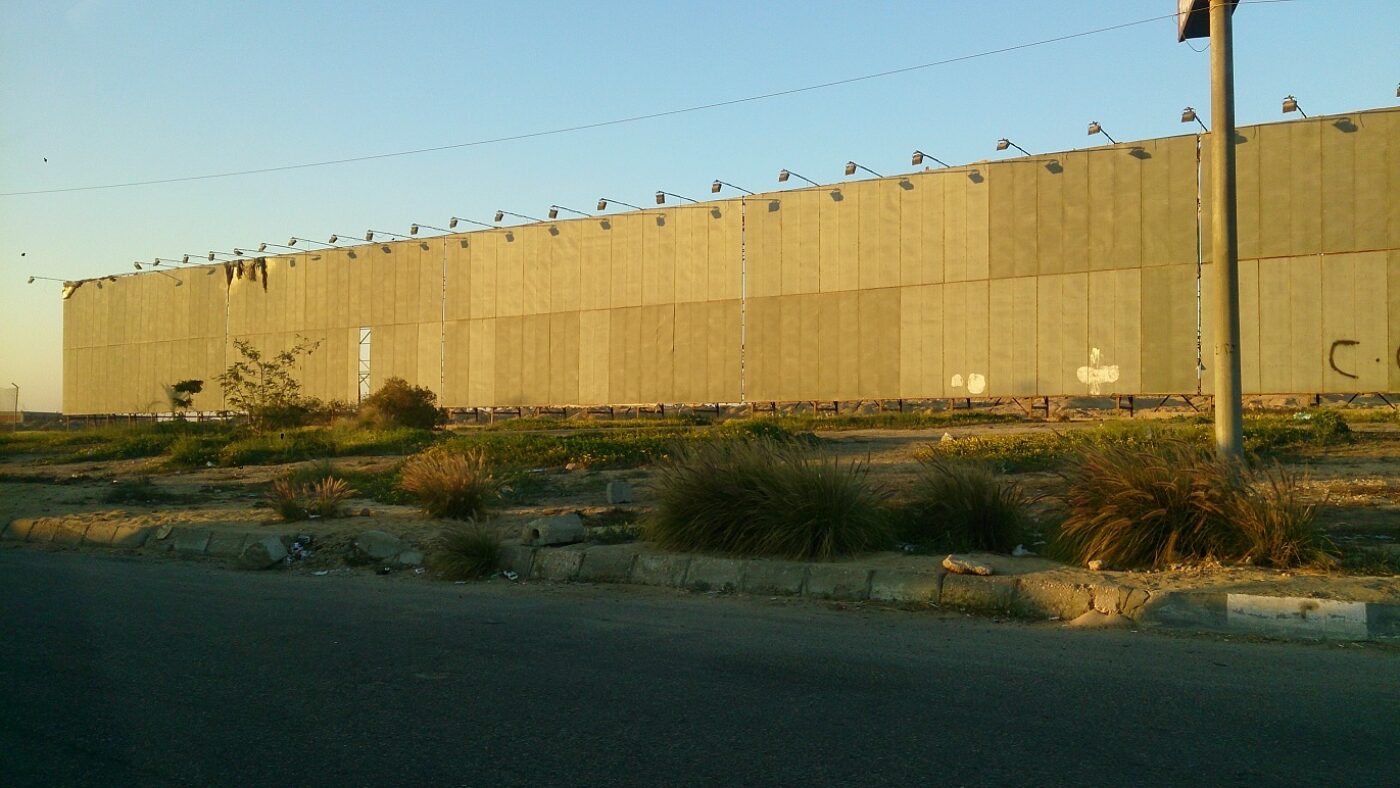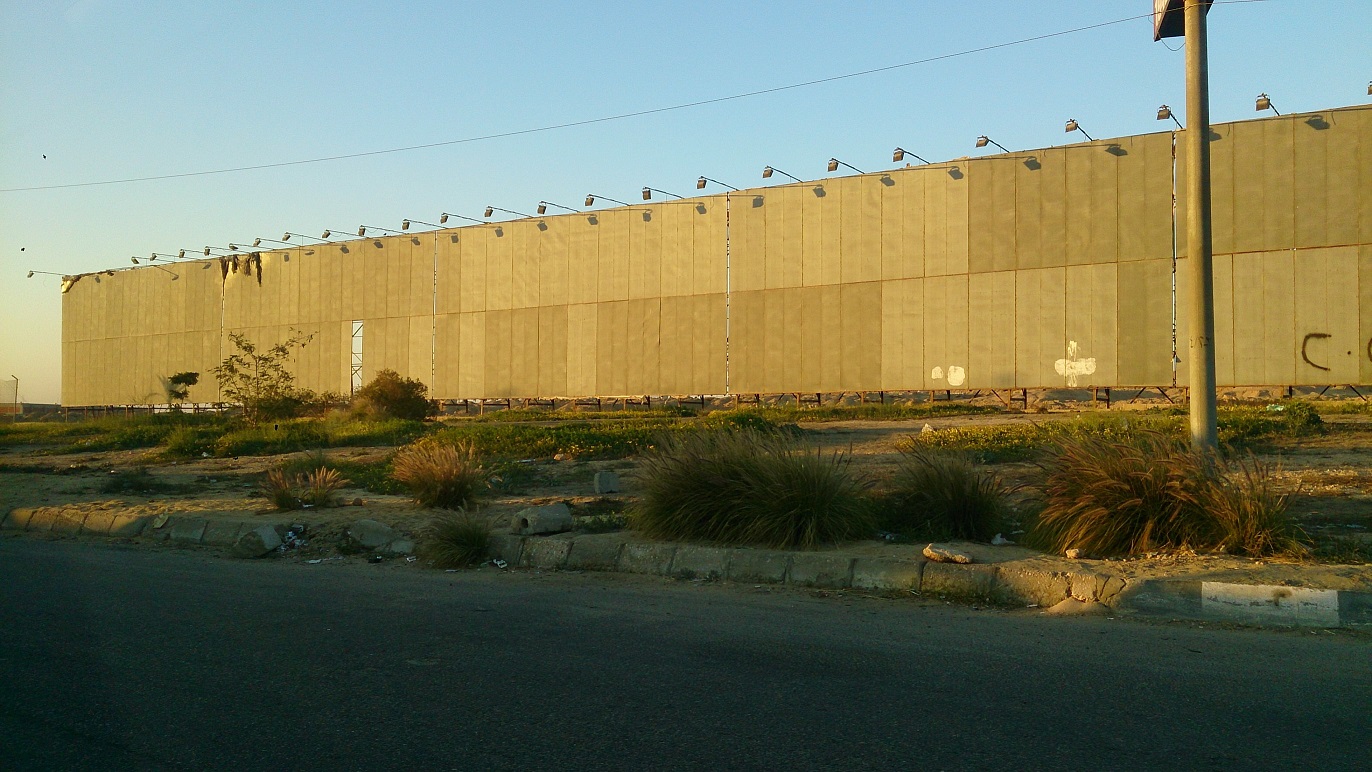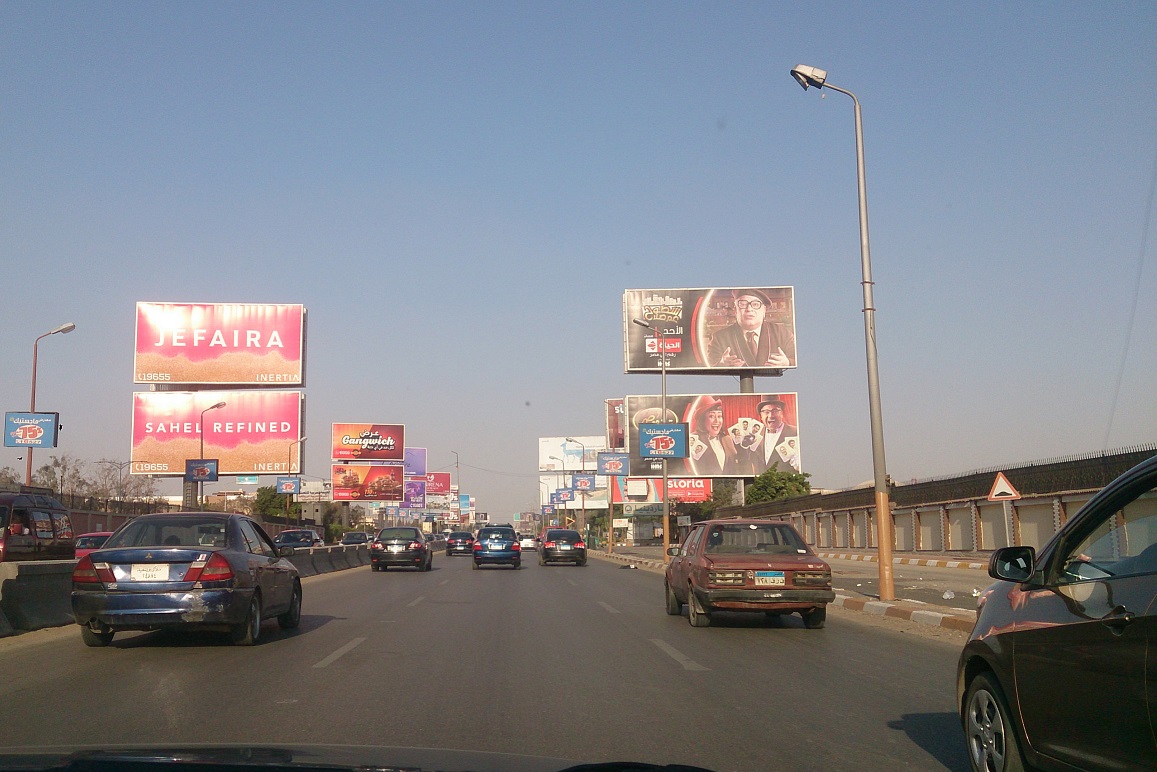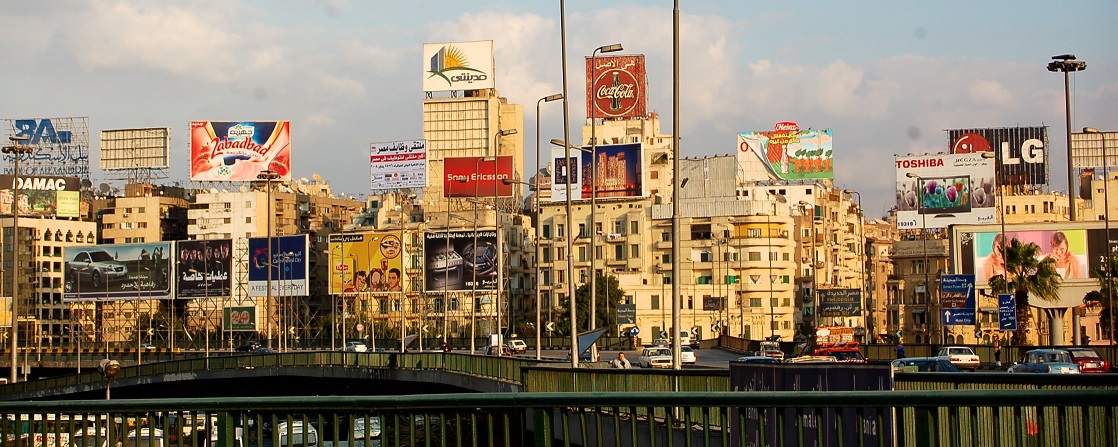
In a city where the roof of a building is the fifth facade for advertisement and billboards function as fences, streets and sidewalks are the places where space is negotiated by the citizens. In this speculative and subjective article, Yasmin Mardini argues that the arterial system of Cairo represents the public space where mutually exclusive localities are temporarily brought together.
The surest way to go about deconstructing and understanding the urban exclamation that is Cairo is to actively suspend disbelief. On the surface, Cairo is a recurring urban mistake; one that is barely concealed and often ridiculous. A city that presents itself as a study in contrasts – a place that has seemingly long since passed and yet continues to host anyone who cares to populate it. This predictable paradox of unsustainable urban continuity and exponential density makes it the ideal subject of many frustrated academic and political outcries. Lodged somewhere between tall tales of apocalyptic slums and news headlines of revolutionary street strife, Cairo’s popular urban discourse firmly plants its footing in a regressive enthusiasm for dystopian narrative rather than urban analysis. However, political bias and warnings of impending doom aside, there are readable forces at play that actually shape the disorderly city we maneuver today. And in order for any discourse on Cairo to ever assume practical urban consequences, the dialogue needs to distance itself from the prevalent political discussion, which may be the main trigger of most present discourse on the city, but is also, incidentally, the greatest limitation to offering viable, objective urban readings.
To dismiss or romanticize Cairo, as so often happens, is to reduce and underestimate it; to think of Cairo as anything other than a lucky state of shortage and demand is to fail to recognize the potentials it has to offer. Cairo is location: parceled, rented, or sold. It is a city of many separate individual systems, formal and informal alike, all trading in space and capitalizing on population density. The complexity of Cairo’s layers is readable to its locals; the non-discerning consumers who recognize the manifestation of multiple layers of demand and self-made supply. At its core, Cairo is property; and in a city where space is a commodity, property is lucrative.
As might be expected, Cairo’s urban fabric bears the full brunt of its economic changeability. Among the numerous displays of consumer urbanism, outdoor urban advertisement has achieved a recently exaggerated frequency visible today in the city’s urban realm. A phenomenon that is typical of dense megacities, especially ones with so sizable a wealth gap, urban advertisement in Cairo proudly presents near-permanent structures displaying temporary content with recurring messages of unaffordability that shape millions of people’s urban memories and associations. The following work is an attempt to infer a more opportunistic meaning behind this recently amplified phenomenon of urban advertisement in Cairo and to propose an alternative way to consider the notion and manifestation of public space in the city. This piece is speculative and subjective, and does not pretend to be more than what it is; one more opinion on Cairo’s wishful urbanism.

Space Assigned to No One
As established above, Cairo is a city of consumption; and the urban practical consequence of capitalist, consumerist cities is privatization. The most visible and active form of urbanism in the city is the collective effort of enclosure, exclusivity, and membership that ranges from public parks to gated communities. The message is simple; space is considered more viable when defined and hierarchy more readable – this practice does not only commodify space, it rates it on a scale. The act of pricing visual space is an extension of this fence culture; urban advertisement is not a phenomenon that occurs without context, it is a symptom of a consumer culture that has adopted and preferred privatization as a mode of urbanism. Billboards and bulletins in their recent frenzy are an encroachment of privatization over a supposedly public and diverse city scape. The very canvases of advertisement may as well be fences that alienate city users by employing barriers of content, language, scale, and imagery; a blanket form of advertisement on a public sphere that cheerfully informs a majority that they are on the wrong side of the fence. What this divisive phenomenon throws into sharp relief, however, is the host layer that allows urban advertisement to exist; the unconditioned street and sidewalk at the other side of every enclosure and the tired public route around which life occurs in Cairo. Streets are the only form of public, diverse, and non-privatized space in the city; space that is assigned to no one and hence everyone. This omnipresence of urban advertisement highlights, by contrast, the communal connotations of streets in our urban fabric and the opportunistic practices, like advertising, that have gained footing within that setting solely because there is no other manifestation of truly diverse and strategically exposed space available.
Other Words for Public Space
In a city where public parks are fenced, waterfronts are privately owned, and roofs are rented as upright fifth façades for advertising, it should come as no surprise that Cairenes display an inherent skepticism of all things public or free. In the grand scheme of Cairo, urban advertisement is simply one more way a street has served this city as a profitable layer of consumption. Claiming sidewalks in the form of kiosks, carts, stands, and seating has always been a Cairene practice; one that stems from an exercised and practiced mentality that has taught the public that streets and their sidewalks are the only forms of acceptable unbuilt space in a city designed around lucrative enclosures. To have a single urban layer, in spite of Cairo, immune to privatization while also being an infrastructure that hosts everyone whether they prefer it or not produces an entirely different understanding of what could be construed as public space.
Streets and sidewalks are the largest manifestations of negotiation for space in a metropolis like Cairo; they are a daily exercise in vague ownership, verbal and visual feedback, and voluntary and involuntary exchange. In a sense, these urban infrastructures are the communal lifeline of our privatized city. Whether a resident of an exclusive fenced haven or a stigmatized extra-legal community, one is bound to traverse the streets of Cairo and actively participate in the cycle of their surrounding industries. From a typical urban standpoint, public space in Cairo is negligible if available and still very far from being considered an urban right. The definition of public space that I speak of, in this instance, is a collection of decentralized public realms within the city that are freely accessible to users of all backgrounds; spaces that may also encourage trade or exchange and yet are not solely limited to those who can afford them. By that ideal description, the only remaining space we have fulfilling these criteria is representative, arterial infrastructure; main streets and ring roads that encircle most of our city, define our daily interactions, and host the greatest display of financial and social diversity in Cairo. Unsurprisingly, these are the same roads that also play a prominent role in propping up the projected image of our city, providing surface representation to locals and foreigners alike. What the city’s applied urban logic essentially suggests is a single layer upon which all of Cairo’s endeavors and failures begin and end, the route that assumes responsibilities beyond its scope.
Streetside Urbanism
As should be inferred, there are numerous types and scales of streets in Cairo and, accordingly, different manifestations of activities and spatial overlaps at various stages of establishment. From alleyways to main streets, the presence of pedestrians or idle bystanders and the concept of un-designed spillovers of ground floors, stationed kiosks, or temporary stalls may differ in scale and frequency, but it is a common feature of the city. While side streets and inner city routes feature more valid examples of productive use, the arterial road offers a more diverse cross section through society by being an element of urban cohesion that temporarily ties many, otherwise exclusive, localities and hence people to the same domain. The arterial route is also further set apart because it directly represents the dramatic pace of evolving urbanism in Cairo; a pace that defines the scale and development of entire neighborhoods in the process. The following paragraphs thus cite the Ring Road, Salah Salem Street, and the 6th of October Bridge as examples of arterial streets in the city where the differences in scale, advertisement frequency, surrounding development, and pedestrian presence are pronounced. These three brief samples, in my understanding of Cairene urbanism, highlight the existing qualities of streets as routes that launch development wherever they extend, as well as, unofficial open spaces that people have, in some cases, come to view as viable space for use. The comparison between these selections is intended to underscore the potentials of streets as available tools at our disposal; domains to someday officially assign public capacities to and design complex overlaps of use for, the same complexities that already manifest themselves, if haphazardly, today.
I. Ring Road
The Cairo Ring Road is the city’s most prominent transportation route which circles and offers access to most of Cairo’s urban areas and acts as a conduit for future development projects that flank the newer sections of the Ring Road on both sides. At its most recent extensions, it is a long journey around Cairo’s mostly undeveloped desert expanse; one accompanied by the continuous and large presence of billboards and bulletins. Urban advertisement here acts as a front for future development schemes and advertises images of cities that will one day take their rightful street-side places and advertise themselves. The areas developed around the more recent extensions of the Ring Road so far are either shopping centers with a proud buffer of parking spots or gated communities that have been planned with no urban precedence to draw from or nearby context to look to beyond the reliable recipe of the fence, the parceled land, and the main street.

II. Salah Salem (and by extension El Matar and Orouba St.)
Salah Salem Street, eastern Cairo’s very own ring road, offers a more developed route through long- established Cairene neighborhoods. Unlike the Ring Road, which only addresses vehicles while pedestrian presence remains an unwelcome sight, Salah Salem St. has its fair share of pedestrian bridges and the distinct possibility of individuals or groups crossing the street at any given moment. In the past few years, the street has witnessed an increase in its own share of add-on urban advertisement structures that have managed to locate residual space to occupy on its sidewalks. The billboards present are mostly uniform in size and regular in placement; the repetitive effect appears to signal a compromise by the surrounding fenced plots in allowing the advertising element into their fold while still projecting a sense of surface dignity. Urban advertisement, in this instance, pretends to offer representation and orderliness, a visual extension of concepts of black and white sidewalk stripes.

III. 6th of October Bridge
Devoid of all pretensions of order, the 6th of October Bridge illustrates an almost comical overlap of street, advertisement, and user. The bridge and its surrounding buildings’ façades and roofs, sidewalks, fences, and balconies, near or distant, are all potential advertising surfaces. In fact, the distinction and hierarchy of value between canvas and built space become unclear when entire complex structures are mounted onto building façades to project blown-up images of dairy products. Negotiation for space, in this scenario, has far outgrown the available space itself. Here, negotiation is used in the loosest sense of the word; the same way sitting in an occupied seat on a bus could be considered a compromise. Billboards and bulletins on this bridge offer lucrative leases to the surrounding building owners; the fortunate proprietors of private office and residential buildings in the area who recognize the lucrative opportunity in renting out strategically visible surfaces of their buildings in relation to the bridge. Seen in this profitable light, the public discourse typically occupied with ideal notions of aesthetics and outcries against visual pollution departs from this preoccupation with planned order and frequency, and instead crosses over to a preferred anticipation of profit and industry.

Minimum Planning, Maximum Use
What the Ring Road, Salah Salem St., and the 6th of October Bridge essentially represent is a tableau of correlation between route and city development, an evolutionary progress of streets and the cities that are elevated around them. The Ring Road features a wider street and projects a sprawling road-side urbanism; one that does not address the inevitably arriving pedestrian scale or does not plan to host it, much in the same way Salah Salem St. was once intended. One could imagine a similar effect when the 6th of October Bridge was first realized—the distant and unlikely possibility of an arterial road to ever be reduced to an interrupted sphere of visual and literal haggling. Simply put, there is always a perceived loss of sanctity that occurs in Cairo and arrives with development, occupancy, and an encroaching pedestrian scale; an unwanted presence that responds to privatization and can only find space to materialize on and around even the arterial street. It is this same loss of sanctity that renders order irrelevant and allows built spaces and sidewalks to yield to the easy, lucrative fate of being potential canvases for advertisement. From ring road to bridge, the evolution of the Cairene street from vast infrastructure to unofficial public space and possible industry is noteworthy. Regardless of your stance on satellite city development or informal autonomous encroachment, it is important to note that the street is Cairo’s only actual tool of eventual urban place-making. Seen in this light, Cairo becomes both a cautionary tale and an impressive example of urban planning that provides the bare minimum infrastructure, street without sufficient transportation, and expects demand and eventual occupancy to provide the rest.
Also noteworthy is the fact that Cairenes have adapted to these practices; we have evolved as city users who are now able to navigate more obstacles, find residual space to occupy, and create spaces that were not planned for us. Cairenes are the product of spatial opportunism and a planning system that is not versed in open space. Nevertheless, Cairo works; sometimes in the worst ways, but there is an order to it, readable to its locals like an acquired taste. On a good day, one might theorize that, unintentionally, we have become experts in city use and city production, we understand the cost of urbanism and the reproducibility that comes with unmet demand and extreme density. We have become practiced in manipulating the short-term memory of cities, producing city images, and accepting hit-and-run developments that have little to show for beyond foreign branding and surface infrastructure – anonymous streets that we will one day fashion into space of our own.

Inconclusive Projections
It is important to note and remain aware that the reigning mode of privatized urbanism and the, politely put, less than ideal standards of urban legislation associated with Cairo are issues common in dense, especially third world, megacities. Nonetheless, while not entirely unique in its condition as this dense, demanding metropolis, Cairo, unlike its global counterparts, is as unapologetic about the resulting urban structure it spares for its dwellers as it is unfettered by notions of public accountability. In fact, there may be a multitude of parallels to draw between Cairo and many other global cities, but what remains remarkably Cairene is the stark discrepancy between an inherent, and largely accepted, hierarchy of urban filtering and enclosure, and an unspecialized street layer, ready and available at the edge of every enclosed oasis, immune to this very same hierarchy. Planned enclosure in Cairo is embedded in the city’s collective memory as the best case scenario of urbanism, so much so that the city’s locals, of different educational and financial backgrounds, all aspire to belong within its walls. And it is in this discrepancy that this piece finds its premise, in the very fact that the only product of orchestrated enclosure is, ironically, raw, unconditioned openness.
While arterial routes currently host the most visible display of aggressive advertisement and booming visual industry, they do not (yet) feature productive use. And most would, rightly, argue that arterial routes have no business being interrupted places of lingering and exchange. The point this piece and its main comparisons are meant to make is that, taken out of context, the arterial road and sidewalk remain unforgiving, alien, and vast landscapes; however, in a context of sweeping urbanism and within a frame of near-constant production of new cities, the surrounding fabric is developed and the arterial route of today is eventually reduced to the main street of tomorrow. The vehicular priority shifts, however reluctantly, to accommodate the pedestrian and a new dynamic, speed, and scale are introduced; so, in a sense, yesterday’s transitory space is tomorrow’s advertising host surface, unofficial crowded bus stop, and possibly even lived-in curb. Understanding and learning to read the patterns of our urban development ensures our ability to reserve space for our needs squarely within the imminent new context and allows us room to not always arrive in retrospect.
Much of the above has always been, and will largely always be, brave projections on paper that neither offer nor assume a tangible set of guidelines toward actual, enforceable change. And while observation may not be an exact science, it is the only way to challenge and question the established myths associated with (third world) urbanism, which is not an exact science in itself either. So if we were to maintain the suspension of our collective disbelief for a short while longer, we could consider what it means to have a ubiquitous, un-designed, and unspecialized domain in the city, framing, both our journey to and the setting of, our destinations. The street and sidewalk duo’s omnipresence in every urban context, be it alley or ring road, allows it to potentially be the largest and most continuous urban life form to assume, whether successfully or disastrously, the role of public space. The Cairene street is both the self-proclaimed antidote to enclosure and privatization’s greatest accidental urban product at once. Understood as dormant, decentralized public layers, part and parcel of everyday urban existence, the street and sidewalk allow for a much-needed abstraction of public space to a time of day, an activity, an opportune intervention rather than a permanent central, idle space to travel specifically to; a centralization of leisure rendered obsolete by a dense, disparate, and scheduled city. In the same way the city has been, if subconsciously, abstracted to inside and outside, better and worse, controlled and chaotic, maintained and neglected: private and public – so too must public space abstract itself to momentary opportunity and the street and sidewalk remain actively unspecialized and ready to one day host the inevitable demands required of them.
Yasmin Mardini is a recent architecture graduate and an aspiring architecture writer from Cairo, Egypt.